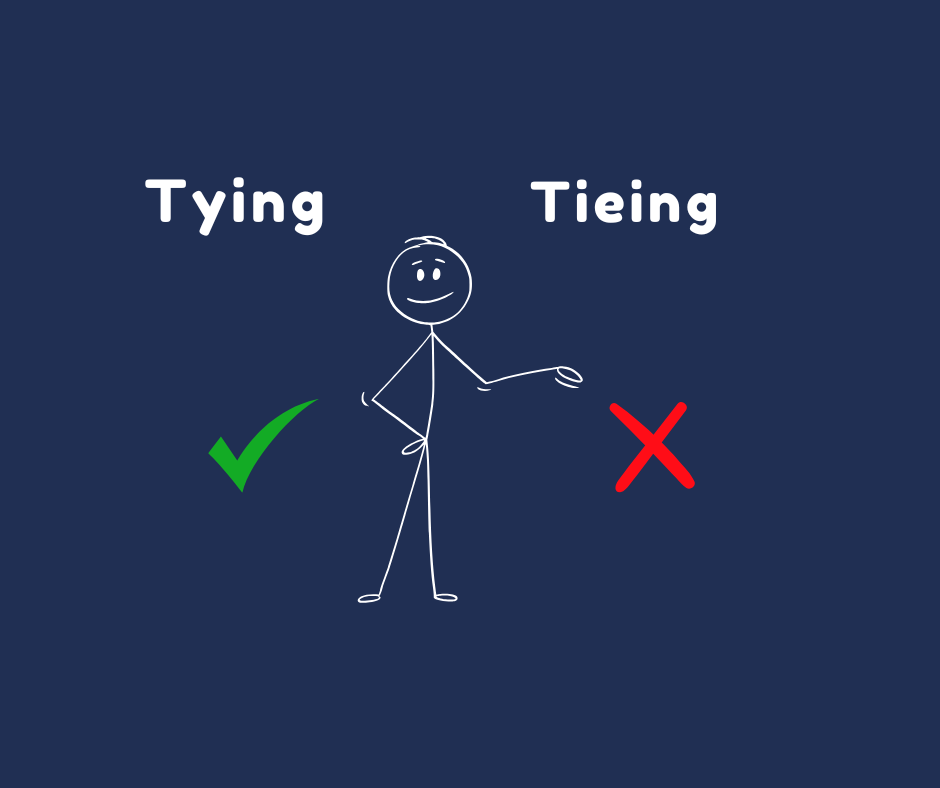Tying or Tieing ?Which One is Correct ?
Have you ever paused mid-bow and wondered, is it ‘tying or tieing ?”, “Am I tying my shoes or tieing them?” This simple question reveals a common dilemma that can leave even the most confident writers in doubt. Understanding the correct spelling of ” tieing or tying ” is not just an academic exercise; it reflects on our communication skills in everyday life.
This guide will help you resolve the mystery of “tying vs tieing,” confirming which spelling is correct and you would be able to understand when and where each should be used .Elevate your writing skills with practical tips to avoid this common pitfall in the future.
Why is There Confusion Between “Tying or Tieing “?
The confusion between “tying or tieing” often arises from subtle complexities of English spelling rules.
According to English grammar rules, verbs ending in “-e” usually drop the final “-e” before adding “-ing” to form the present participle.
For example:
- Make → Making
- Bake → Baking
- Hop → Hopping
- Run → Running
However, “tie” is a unique case;
when a verb ends in “-ie” (like “tie”), the spelling rule changes:
- Die → Dying
- Lie → Lying
- Tie → Tying
In this case instead of just simply dropping the “-e,” the “-ie” changes to “-y” before adding “-ing.”
If you find any confusion between some other words like “writing or writting “, you may read that guide as well to figure out correct usage of the term .
How Do You Spell “Tying ” or ” Tieing “: Which one is Correct?
The main confusion between “tying vs tieing” arises because both are related to the verb “to tie.” While “tying” serves as the present participle form, referring to an ongoing action
Example :
→ “She is tying her shoes’
→ He is tying his black and gold tie before heading to the formal event
“Tying” is the correct and most commonly used spelling in modern English. It means fastening or securing something with a knot or loop.
For example:
- Tying your shoelaces before a run.
- Tying a ribbon around a gift.
- Tying a rope to secure a boat.
Though logically one can say that “ tieng” is correct but it does not follow standard English spelling rules. How do you spell tieing“ correctly is important .Tieing” is mostly mistakenly used due to a phonetic interpretation of the word. This misunderstanding highlights how common usage can sometimes lead to errors that become entrenched in our writing habits.
So using “tying” would make your writing clear, correct, and easy to understand as it follows proper grammar and spelling rules, avoiding any confusion for readers.
Whether you’re tying a knot, tying shoe laces , or tying up curtains , “tying” is the only correct choice between tying or tieing .
What Does “Tying” Mean?
The verb tie has several meanings :
- It is ‘to fasten two ends of a long material together
Or
- to form a knot or a bow.
- “ tying “ is used when forming a relationship or bond, especially in the context of marriage.
“tying “ Usage :
The word “tying” is the present participle of the verb “tie” and refers to the act of fastening, securing, or binding something using a shoelace, ribbon, or fabric.
Daily Life Example
- Before heading to the country themed event, he carefully tied his silver tips for bolo tie
- To complete his look, he tied a blue suit blue tie for the democratic meeting.
- He found her busy tying the ribbons on the gift boxes for the party.
- The basketball game ended in a tie, as both teams finished with 80 points.
These examples make idea clear about confusion between “tying or tieing”.
Words Following the -ie to -y Rule
Die → Dying
Lie → Lying
Tie → Tying
Cry → Crying
Fry → Frying
Pry → Prying
Spy → Spying
Synonyms of “Tying”
- Binding – Fastening or securing something tightly with a material like rope or string.
- Example: The book was bound with leather.
- Securing – Making something safe or fastened to prevent movement or loss.
- Example: She secured the package with tape.
- Fastening – Attaching or joining something in a way that it stays in place.
- Example: He was fastening his seatbelt.
- Attaching – Joining one thing to another, typically using a method that keeps it in place.
- Example: The sign was attached to the wall.
- Knotting – Tying something in a knot to hold it together.
- Example: She was knotting the ropes tightly to hold swing in place.
- Strapping – Using a strap to secure or fasten something.
- Example: He was strapping the luggage to the roof.
- Wrapping – Enclosing something by folding or coiling material around it.
- Example: She was wrapping the gift with colorful paper.
- Coupling – Joining two things together, often in a mechanical or physical sense.
- Example: The engineer was coupling the two parts of the machine.
- Connecting – Linking two things together to make them work as a whole.
- Example: He was connecting the wires for the new lamp.
- Linking – Joining together by means of a physical or figurative connection.
- Example: The project is linking various teams for collaboration.
Etymology of “Tying”
The verb “tying” traces its roots back to Middle English “teien” and Old English “tigan,” This word is rooted in the Proto-Germanic word “tīgō,” related to “tīhan” in Old Norse, both of which give the idea of binding or tying things together.
primarily associated with securing items such as shoes through knotting string an everyday act that symbolizes stability but as language evolved, so too did the meanings associated with tying, expanding into rich figurative expressions.
Over time, “tie” evolved in English to refer not only to physical actions like binding objects but also metaphorical uses, such as forming relationships or connections. The transformation of “tie” into “tying” follows a standard grammatical pattern in English, where verbs ending in “-e” or “-ie” change to “-y” before adding the suffix “-ing” (as seen in other words like “die” → “dying”).
Conclusion
Recognizing the right spelling for “tying “ or “tieing “ deepens our understanding of the language. In an age where precision is crucial, especially in professional and academic contexts, the incorrect spelling of “tieing” can confuse readers .
There is no other trick to remember the correct spelling of “tying “But remembering that the correct spelling of “tying” follows an important rule in English:
Rule : verbs ending in “-ie” change to “-y” when adding “-ing.” Whether you’re talking about physically fastening something, like tying a knot or securing your shoelaces, or using it in a more metaphorical sense, such as tying relationships or obligations, “tying” is the proper form.
Sources
Merriam-Webster (Tying Definition & Meaning) and Etymonline (tie | Etymology of tie by etymonline).
Is it tying up or tieing up?
It is “tying up”. “Tieing up” is a common spelling error.
When should I use tieing instead of tying?
You should never use “tieing”. The correct form is “tying” in all contexts.
What is the meaning of tying or tieing ?
“Tying” means fastening or binding something with a knot. “Tieing” is a misspelling of “tying.”
Is it tieing or tying the knot?
It is “tying the knot”. “Tieing the knot” is a common misspelling.







